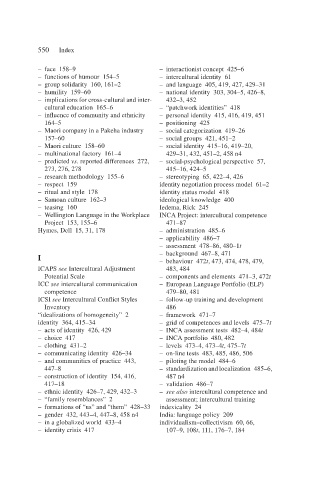Page 572 - Handbooks of Applied Linguistics Communication Competence Language and Communication Problems Practical Solutions
P. 572
550 Index
– face 158–9 – interactionist concept 425–6
– functions of humour 154–5 – intercultural identity 61
– group solidarity 160, 161–2 – and language 405, 419, 427, 429–31
– humility 159–60 – national identity 303, 304–5, 426–8,
– implications for cross-cultural and inter- 432–3, 452
cultural education 165–6 – “patchwork identities” 418
– influence of community and ethnicity – personal identity 415, 416, 419, 451
164–5 – positioning 425
– Maori company in a Pakeha industry – social categorization 419–26
157–60 – social groups 421, 451–2
– Maori culture 158–60 – social identity 415–16, 419–20,
– multinational factory 161–4 429–31, 432, 451–2, 458 n4
– predicted vs. reported differences 272, – social-psychological perspective 57,
273, 276, 278 415–16, 424–5
– research methodology 155–6 – stereotyping 65, 422–4, 426
– respect 159 identity negotiation process model 61–2
– ritual and style 178 identity status model 418
– Samoan culture 162–3 ideological knowledge 400
– teasing 160 Iedema, Rick 245
– Wellington Language in the Workplace INCA Project: intercultural competence
Project 153, 155–6 471–87
Hymes, Dell 15, 31, 178 – administration 485–6
– applicability 486–7
– assessment 478–86, 480–1t
– background 467–8, 471
I
– behaviour 472t, 473, 474, 478, 479,
ICAPS see Intercultural Adjustment 483, 484
Potential Scale – components and elements 471–3, 472t
ICC see intercultural communication – European Language Portfolio (ELP)
competence 479–80, 481
ICSI see Intercultural Conflict Styles – follow-up training and development
Inventory 486
“idealizations of homogeneity” 2 – framework 471–7
identity 364, 415–34 – grid of competences and levels 475–7t
– acts of identity 426, 429 – INCA assessment tests 482–4, 484t
– choice 417 – INCA portfolio 480, 482
– clothing 431–2 – levels 473–4, 473–4t, 475–7t
– communicating identity 426–34 – on-line tests 483, 485, 486, 506
– and communities of practice 443, – piloting the model 484–6
447–8 – standardization and localization 485–6,
– construction of identity 154, 416, 487 n4
417–18 – validation 486–7
– ethnic identity 426–7, 429, 432–3 – see also intercultural competence and
– “family resemblances” 2 assessment; intercultural training
– formations of “us” and “them” 428–33 indexicality 24
– gender 432, 443–4, 447–8, 458 n4 India: language policy 209
– in a globalized world 433–4 individualism–collectivism 60, 66,
– identity crisis 417 107–9, 108t, 111, 176–7, 184

